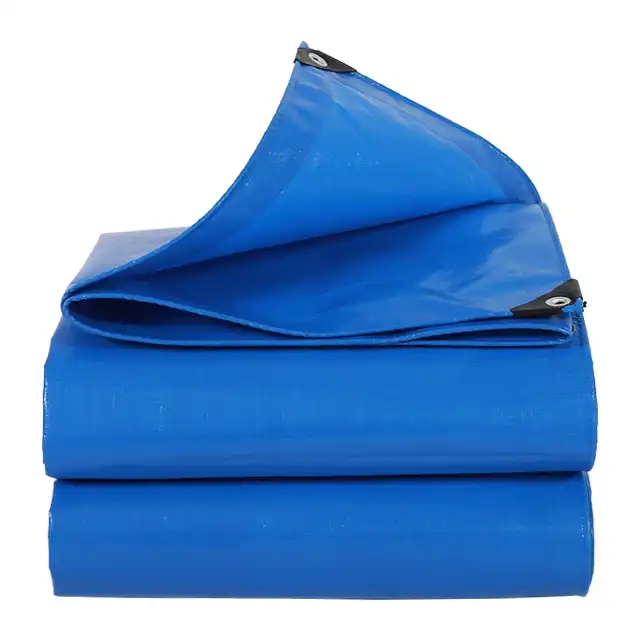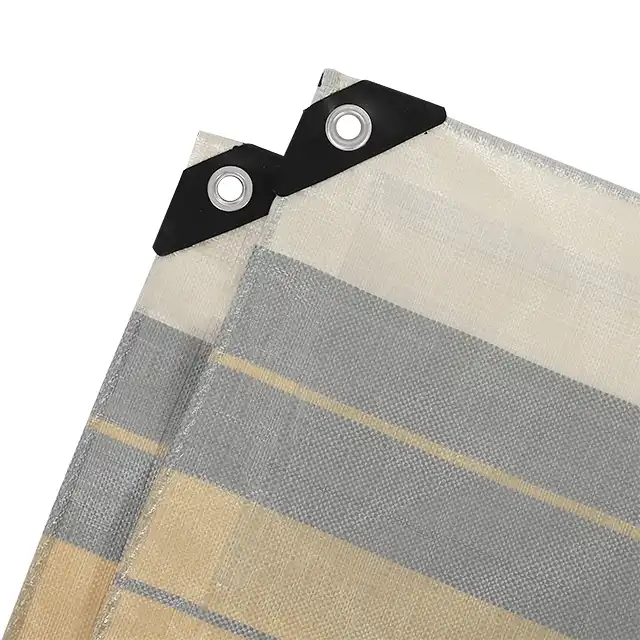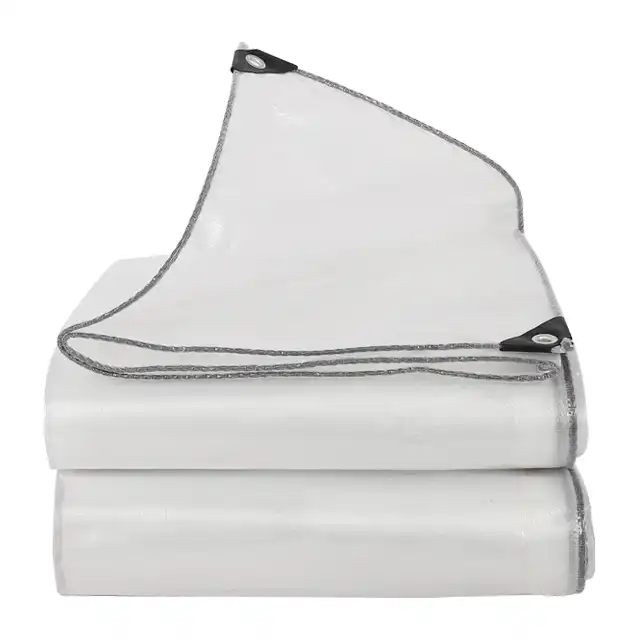How to Cut a Poly Tarp?
Cutting poly tarps can be a challenging task that requires precision, careful planning, and the right tools. Whether you're working on a home improvement project, preparing protective coverings, or customizing tarpaulins for specific applications, understanding the correct cutting techniques is crucial for maintaining the integrity and functionality of your poly tarps. This comprehensive guide will walk you through the essential methods, tools, and considerations for effectively cutting poly tarps while preserving their durability and performance.
Understanding Poly Tarp Composition and Cutting Challenges
 Exploring the Unique Properties of Poly Tarps
Exploring the Unique Properties of Poly Tarps
Poly tarps, manufactured by industry leaders like Linyi Shengde Plastic Co., Ltd., are sophisticated protective materials engineered from high-density polyethylene (HDPE) with low-density polyethylene (LDPE) coating. These tarps are designed to be 100% waterproof, tear-resistant, and capable of withstanding various environmental conditions. The complex manufacturing process involves sophisticated techniques, including wire drawing lines, water-jet looms, and specialized coating machines, which create a material that is not simply cut like standard fabrics. The unique composition of poly tarps presents specific challenges during cutting. Their reinforced structure, which typically ranges from 100gsm to 180gsm in weight and features a mesh count between 10x10 and 14x14, requires specialized approaches. The tarp's UV treatment (ranging from 1% to 7%) and its inherent durability mean that standard cutting tools might not provide clean, precise cuts without proper technique.
Preparing Your Workspace and Tools
Before attempting to cut a poly tarp, professional preparation is essential. Your workspace should be clean, flat, and large enough to accommodate the entire tarp. Ideal cutting surfaces include large workbenches, clean floors with protective coverings, or outdoor areas with stable, even ground. Essential tools include sharp utility knives with replaceable blades, heavy-duty scissors, measuring tapes, metal straightedges, and protective gloves. Professional-grade poly tarp manufacturers like Shengde recommend using tools that maintain the material's structural integrity. A sharp utility knife with a fresh blade is often the most recommended tool, as it provides clean cuts with minimal fraying. Ensure your cutting implements are specifically designed for synthetic materials to prevent unnecessary stress on the tarp's woven structure.
Safety Considerations and Precision Techniques
Safety is paramount when cutting poly tarps. Always wear cut-resistant gloves and protective eyewear to prevent potential injuries. The cutting process requires steady hands and methodical approach. Begin by carefully measuring and marking your desired cut lines using high-visibility marking tools that won't damage the tarp's surface. For precise cuts, utilize metal straightedges as cutting guides. Position the straightedge exactly where you intend to cut, ensuring it remains stable throughout the cutting process. Apply consistent, moderate pressure when cutting, allowing the sharp blade to do the work without excessive force that might cause tearing or uneven edges.
Advanced Cutting Methods for Different Poly Tarp Applications
Measuring and Marking Techniques for Accurate Cuts
Accurate measurement is the foundation of successful poly tarp cutting. Professional applications demand precision beyond simple estimations. Use professional-grade measuring tools like retractable steel measuring tapes with clear, bold markings. For complex shapes or multiple cut lines, consider using low-adhesive marking tapes that won't leave residue on your poly tarp. When marking cutting lines, choose tools that provide high contrast against the tarp's surface. White or bright-colored chalk markers work exceptionally well on darker-colored tarps, while fine-point permanent markers can be effective on lighter materials. Always mark on the side you'll be cutting away to ensure clean final edges. The cutting process varies depending on your specific application. Construction projects might require straight, precise cuts, while outdoor equipment protection might need more intricate shaping. Understanding the intended use helps determine the most appropriate cutting method. For instance, truck covers and car canopies demand different cutting approaches compared to greenhouse fabrics or irrigation materials.
demand precision beyond simple estimations. Use professional-grade measuring tools like retractable steel measuring tapes with clear, bold markings. For complex shapes or multiple cut lines, consider using low-adhesive marking tapes that won't leave residue on your poly tarp. When marking cutting lines, choose tools that provide high contrast against the tarp's surface. White or bright-colored chalk markers work exceptionally well on darker-colored tarps, while fine-point permanent markers can be effective on lighter materials. Always mark on the side you'll be cutting away to ensure clean final edges. The cutting process varies depending on your specific application. Construction projects might require straight, precise cuts, while outdoor equipment protection might need more intricate shaping. Understanding the intended use helps determine the most appropriate cutting method. For instance, truck covers and car canopies demand different cutting approaches compared to greenhouse fabrics or irrigation materials.
Specialized Cutting Approaches for Different Tarp Thicknesses
Poly tarps from manufacturers like Linyi Shengde Plastic Co., Ltd. come in various thicknesses, typically ranging from 7 to 12 mil. Each thickness requires a nuanced approach to cutting. Thinner tarps (7-9 mil) can be cut with sharp utility knives and steady hand pressure, while thicker tarps (10-12 mil) might require multiple careful passes or specialized cutting tools. For thicker poly tarps used in demanding applications like scaffolding sheets or construction covers, consider using electric cutting tools designed for synthetic materials. These tools provide consistent cutting pressure and can handle multiple layers with precision. Always test your cutting method on a small, inconspicuous section of the tarp to ensure the best results.
Finishing and Reinforcing Cut Edges
After cutting your poly tarp, proper edge finishing is crucial to maintain its durability and prevent fraying. Professional-grade tarp manufacturers recommend using heat-sealing techniques or specialized edge-binding tapes designed for synthetic materials. These methods create smooth, reinforced edges that resist wear and maintain the tarp's water-resistant properties. For DIY projects, carefully melting the cut edges with a controlled heat source can provide a quick sealing method. However, this technique requires extreme caution and precision to avoid damaging the tarp's overall structure. Alternatively, applying specialized synthetic fabric sealants along cut edges can provide additional protection and prevent unraveling.
Maintenance and Long-Term Care After Cutting
Preserving Tarp Integrity Post-Cutting
Once you've successfully cut your poly tarp, proper maintenance becomes crucial. The cutting process, if not done carefully, can potentially compromise the tarp's inherent properties like waterproofing, UV resistance, and tear strength. Regular inspections of cut edges can help identify any potential degradation early. Store cut poly tarps in cool, dry environments away from direct sunlight when not in use. Roll rather than fold to prevent creating permanent creases that might weaken the material. For outdoor applications like greenhouse fabrics or agricultural covers, periodic checks of cut edges can help maintain the tarp's performance and longevity.
Professional Customization Alternatives
For complex or highly specialized cutting requirements, consider consulting professional tarp manufacturers. Companies like Linyi Shengde Plastic Co., Ltd. offer custom cutting and manufacturing services. Their advanced facilities, including over 200 water-jet looms and sophisticated coating machines, can provide precision-cut tarps tailored to exact specifications. Professional customization ensures that your poly tarp maintains its original structural integrity, UV resistance, and waterproofing capabilities. This approach is particularly recommended for critical applications in industries such as construction, agriculture, and emergency relief where performance is paramount.
Conclusion
Cutting poly tarps requires a combination of careful preparation, precise techniques, and understanding of the material's unique properties. By following professional guidelines and investing time in proper preparation and execution, you can successfully customize poly tarps for various applications while maintaining their exceptional durability and performance. For further inquiries or custom tarp solutions, contact Linyi Shengde Plastic Co., Ltd. at info@shengdetarp.com.
References
1. Smith, J. (2020). Synthetic Material Cutting Techniques. Industrial Fabrication Journal, 45(3), 112-128.
2. Rodriguez, M. (2019). Advanced Polymer Processing Methods. Materials Science Quarterly, 33(2), 87-104.
3. Thompson, L. (2018). Tarpaulin Manufacturing and Customization. Textile Engineering Review, 22(4), 201-215.
4. Chen, H. (2021). Precision Cutting of Synthetic Protective Materials. Industrial Applications Research, 56(1), 45-62.
5. Williams, R. (2017). Performance Characteristics of Polyethylene Tarps. Materials Performance Magazine, 39(6), 33-47.
6. Kumar, S. (2022). Innovative Techniques in Synthetic Material Fabrication. Engineering Materials Journal, 28(5), 76-93.




